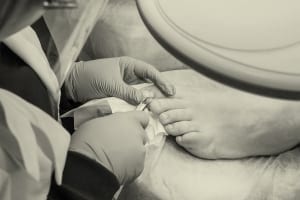Herzliya Medical Center
Tel: +972-9-959-4888
09:00-18:00
 When the nail in one of the toes penetrated the skin and wounds it, to the point of frequent bleeding, infection and even puss secretion, the case is defined as an ingrown nail – a condition considered very typical of the toe in the foot, but can appear in all toes, and even the fingers.
When the nail in one of the toes penetrated the skin and wounds it, to the point of frequent bleeding, infection and even puss secretion, the case is defined as an ingrown nail – a condition considered very typical of the toe in the foot, but can appear in all toes, and even the fingers.
Ingrown nail is perceived as a slight, minor and insignificant injury – perhaps because many cases can be treated independently (so long as it’s not severe). However, neglecting the problem and avoiding treating it can cause many problems and severe damage to the nail and toe, up to damage to the adjacent bone and necrosis.
Ingrown nail treatment will usually be conservative, mostly in the phenomenon’s first stages: soaking the toe in hot water, putting cotton wool under the nail or using a special splint should usually aid in solving the problem or relieving dealing with it. If it becomes chronic, or if there’s a concern for severe damage around the nail and toe, it will be decided to have surgery.
IN the past there were 2 surgical procedures for ingrown nail treatment, which are no longer in use: ‘dissolving’ the nail or ripping it out whole. Since these are fairly aggressive actions, with time, we found other ways to treat the problem without taking such radical steps.
Today, ingrown nail treatment amounts to cutting each side of the ingrown nail so in fact, the nail is missing a relatively thin part throughout it and on only one side. Likewise, some of the nail’s root is pulled in the hazardous area, and thus the treatment ends.
Since this is a surgery done under localized anesthesia, there’s no need for special preparation before it.
Ingrown nail treatment surgery is mostly done under localized anesthesia: the doctor injects an anesthetic into the sides of the damaged toe, and after the anesthesia kicks in, he begins the surgery, which usually lasts no more than several minutes.
As said, during the surgery, the side of the “problematic” nail will be removed throughout. This way, the nail remains without one “side”, but in a relatively thin part, so the esthetic damage is hardly visible. This way, the doctor seeks to prevent the nail from growing in that direction again and in the manner that caused the problem.
To further reduce the risk of ingrown nail recurrence, the doctor also burns some of the “matrix” – nail root – using a chemical/electric substance or laser, right after the removed part. This is another way to prevent the nail from growing in the harmful way again.
After the surgery, you’ll be discharged, after a short while. At first, you’ll have difficulty stepping on the foot or using the hand (depending on where the problematic nail was), but slowly you’ll be able to resume your routine. If you don’t do any strenuous work, you could return from sick leave within 2-3 days. Actions that include prolonged walking, for example, would be possible after about 2 weeks of rest, and so would sports activities combining the legs.
This is a fairly simple procedure that doesn’t hold special risks – aside from bleeding or infection, like in every surgery, that would be treated effectively even within it. One significant side effect is, of course, the possibility of the ingrown nail growing back. The medical literature speaks of a 60% chance of recurrence in a person who hasn’t had the surgery, and only 10% chance in one who has.